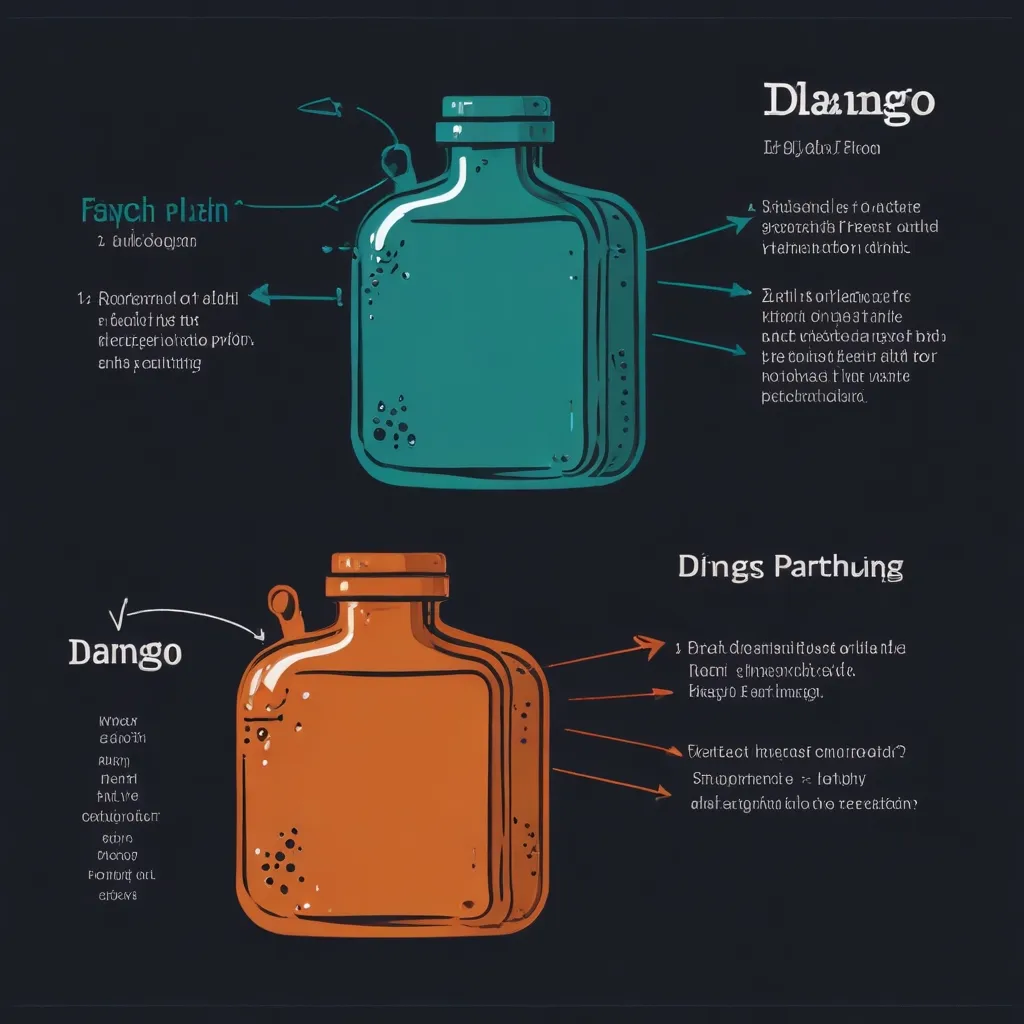Building custom aggregates in Marshmallow is like unlocking a secret superpower for your data serialization needs. If you’ve been using Marshmallow for a while, you might think you’ve seen it all. But trust me, there’s a whole world of untapped potential waiting to be explored.
Let’s dive into the world of custom aggregates and see how they can revolutionize your data handling. First things first, what exactly are custom aggregates? Well, they’re like your own personal data wizards, allowing you to combine and manipulate fields in ways that standard Marshmallow fields just can’t match.
Imagine you’re working on a project where you need to calculate the total price of items in a shopping cart. Sure, you could do this in your application logic, but wouldn’t it be neat if your serializer could handle it for you? That’s where custom aggregates come in handy.
Here’s a simple example to get us started:
from marshmallow import Schema, fields
class TotalPriceAggregate(fields.Field):
def _serialize(self, value, attr, obj, **kwargs):
return sum(item.price for item in obj.items)
class ShoppingCartSchema(Schema):
items = fields.List(fields.Nested(ItemSchema))
total_price = TotalPriceAggregate()
In this example, we’ve created a custom TotalPriceAggregate field that calculates the total price of all items in the cart. It’s simple, elegant, and keeps your serialization logic where it belongs - in your schema.
But we’re just scratching the surface here. Custom aggregates can do so much more. They can perform complex calculations, combine multiple fields, or even interact with external services if needed.
One of the coolest things about custom aggregates is how they can simplify your API responses. Instead of sending a bunch of raw data and expecting the client to figure it out, you can provide meaningful, calculated values right out of the box.
Let’s say you’re building a fitness app. You might have a schema that looks something like this:
class WorkoutSchema(Schema):
exercises = fields.List(fields.Nested(ExerciseSchema))
duration = fields.Integer()
calories_burned = CaloriesBurnedAggregate()
The CaloriesBurnedAggregate could take into account the duration of the workout, the types of exercises performed, and even user-specific data like weight or fitness level to provide an accurate estimate of calories burned. That’s the kind of value-added information that can really make your API shine.
But custom aggregates aren’t just about calculations. They can also be used for data transformation and normalization. Have you ever had to deal with inconsistent date formats in your data? A custom aggregate could handle that for you, ensuring that all dates are serialized in a consistent format regardless of how they’re stored in your database.
from datetime import datetime
class NormalizedDateAggregate(fields.Field):
def _serialize(self, value, attr, obj, **kwargs):
if isinstance(value, str):
value = datetime.strptime(value, '%Y-%m-%d')
return value.strftime('%d %B %Y')
class EventSchema(Schema):
name = fields.String()
date = NormalizedDateAggregate()
This NormalizedDateAggregate ensures that all dates are output in a ‘DD Month YYYY’ format, regardless of how they’re stored. It’s a small touch, but it can make a big difference in the consistency and usability of your API.
Now, I know what you’re thinking. “This all sounds great, but won’t it slow down my serialization?” It’s a valid concern, but in my experience, the performance impact is usually negligible, especially when weighed against the benefits of cleaner, more informative data.
That being said, if you’re dealing with truly massive datasets, you might want to consider caching strategies or moving some of the heavier calculations to background tasks. But for most use cases, custom aggregates are a performance-friendly way to enhance your serialization.
One thing I love about custom aggregates is how they encourage you to think about your data in new ways. When you start looking at your schemas through the lens of “what information can I derive from this data?”, you often discover insights you hadn’t considered before.
For instance, in a social media app, you might use a custom aggregate to calculate a user’s “influence score” based on their number of followers, post engagement rates, and other factors. This kind of derived data can add real value to your application and give you a competitive edge.
class InfluenceScoreAggregate(fields.Field):
def _serialize(self, value, attr, obj, **kwargs):
followers = obj.followers_count
engagement = obj.average_engagement_rate
post_frequency = obj.posts_per_week
# This is a simplified calculation, you'd probably want something more sophisticated in real life
return (followers * engagement * post_frequency) / 1000
class UserSchema(Schema):
username = fields.String()
followers_count = fields.Integer()
influence_score = InfluenceScoreAggregate()
Custom aggregates also shine when it comes to handling complex business logic. Instead of cluttering your views or services with intricate calculations, you can encapsulate that logic within your schema. This not only makes your code cleaner and more maintainable, but it also ensures that the logic is consistently applied whenever that schema is used.
For example, let’s say you’re working on an e-commerce platform that offers dynamic pricing based on various factors like demand, time of day, user loyalty, etc. You could create a custom aggregate to handle this complex pricing logic:
class DynamicPricingAggregate(fields.Field):
def _serialize(self, value, attr, obj, **kwargs):
base_price = obj.base_price
current_demand = get_current_demand(obj.product_id)
time_factor = calculate_time_factor()
user_loyalty = get_user_loyalty(kwargs.get('context', {}).get('user_id'))
return base_price * current_demand * time_factor * (1 - user_loyalty)
class ProductSchema(Schema):
name = fields.String()
base_price = fields.Float()
current_price = DynamicPricingAggregate()
This approach keeps your pricing logic centralized and makes it easy to update or modify as your business rules evolve.
One area where I’ve found custom aggregates particularly useful is in handling legacy systems or external APIs that don’t quite fit your data model. Instead of trying to shoehorn mismatched data into your schema, you can use custom aggregates to transform it into something that makes sense for your application.
For instance, if you’re working with an old system that stores names as a single field, but your app needs separate first and last names, you could use a custom aggregate to split the name:
class NameSplitterAggregate(fields.Field):
def _serialize(self, value, attr, obj, **kwargs):
full_name = obj.name
parts = full_name.split(' ', 1)
return {
'first_name': parts[0],
'last_name': parts[1] if len(parts) > 1 else ''
}
class LegacyUserSchema(Schema):
id = fields.Integer()
name = NameSplitterAggregate()
This way, you can work with the data in a format that suits your needs, without having to modify the underlying data source.
As you dive deeper into custom aggregates, you’ll find that they’re incredibly flexible. You can use them to implement complex validation logic, generate unique identifiers, or even interact with external services to enrich your data.
One word of caution, though: with great power comes great responsibility. It’s easy to get carried away and start putting too much logic into your schemas. Remember, the primary purpose of Marshmallow is serialization and deserialization. If you find yourself writing complex business logic in your aggregates, it might be a sign that you need to refactor that logic into a separate service or module.
In conclusion, custom aggregates in Marshmallow are a powerful tool that can take your data serialization to the next level. They allow you to derive meaningful information, enforce consistency, and encapsulate complex logic within your schemas. Whether you’re building a simple CRUD app or a complex distributed system, custom aggregates can help you create more informative, more useful APIs.
So the next time you’re working with Marshmallow, don’t just settle for the basic fields. Dive into custom aggregates and see how they can transform your data handling. Trust me, once you start using them, you’ll wonder how you ever lived without them. Happy coding!






